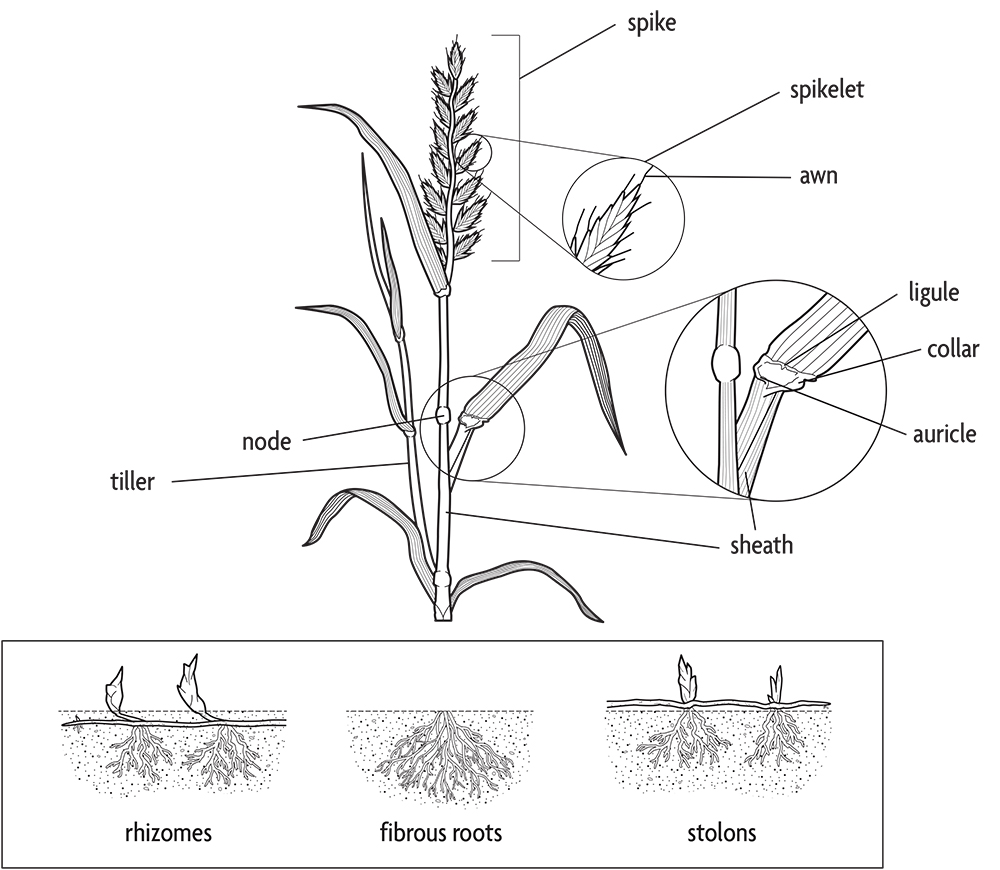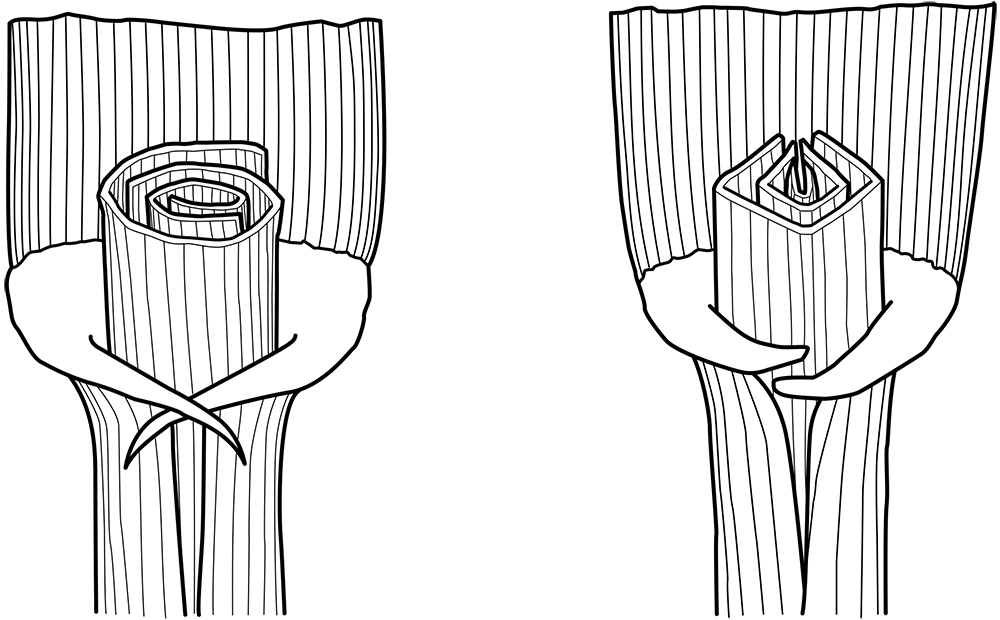After-ripening: The transition of a seed from a dormant to a non-dormant state, which takes place after the seed is physiologically independent of the parent plant.
Allelopathy: The poisoning of one plant by another.
Alternate: An arrangement in which leaves, branches or flowers are not paired along the stem.
Annual: A plant that completes its lifespan in less than one year.
Auricle: An extension of a grass leaf on the collar that wraps partially around the stem (Figure G.1).

Axil: The upper angle of the point of attachment between a stem and a leaf or branch.
Awn: A thin extension on the chaff of a grass flower that typically sticks out beyond the spikelet (Figure G.1).
Biennial: A stationary perennial species that usually sets seeds in the second year of life. The term is a misnomer, since most biennials flower when reaching some minimum size, and this may require several years or, in highly favorable circumstances, only a single year.
Biomass: The total weight of tissue of an individual organism, population or community.
Biotype: A genetically distinct form of a species that persists due to vegetative reproduction or a high level of self-pollination.
Blind cultivation: Cultivation of the whole field including the crop row; for example, with a tine weeder or rotary hoe before crop emergence.
Bolt: A change in primary growth habit from a rosette of leaves to an upright, reproductive stem that is induced by environmental or developmental cues.
Bunch grass: A grass that grows in discrete clumps or bunches rather than spreading to form a sod.
Bur: A fruit with spines or hooked bristles.
Capsule: A seedpod; capsules often have more than one chamber and usually split open to release the seeds.
Cole crops: Crops in the mustard family (Brassicaceae), such as cabbage and broccoli.
Collar: The point on a grass leaf where the sheath transitions to the blade (Figure G.1).
Community: All of the species present in a field. The term is often applied to components of the whole community, for example, the weed community or the insect community.
Cotyledon: The first leaf-like, aboveground structure present on a newly emerging seedling. Derived from seed tissue, cotyledons usually push up through the soil. They are paired in broadleaf plants and singular in grasses and sedges. They are sometimes called seed leaves.
Creeping perennial: A perennial species that spreads by runners, rhizomes or horizontal roots that sprout to form new shoots.
Cultivation: Most broadly, any systematic soil disturbance for agricultural purposes, but as used in this book, it refers to mechanized soil disturbance for weed management after crop planting.
Dough stage: The stage in the development of a seed in which the endosperm is still soft but is no longer liquid.
Dust mulch: A surface layer of loose soil that dries quickly and thereby prevents emergence of weed seedlings.
Endosperm: The food storage part of a seed.
Entire: Describing a leaf with smooth, uninterrupted, toothless edges.
Fibrous root system: A root system composed of thin, branching roots with no taproot (Figure G.1).
Flame weeder: A handheld or tractor mounted burner for killing weeds (Figure 4.16).
Flower head: The “flower” of a plant in the aster family. It is actually made up of many tiny flowers that are tightly clustered together.
Folded in the bud: An arrangement of unopened grass leaves in which the leaves are folded at the midrib (Figure G.2).

Growth rate: The rate of addition of tissue to a plant, expressed in units of weight gain per day.
Guess row: The space between two planter passes.
Indeterminate: The growth habit in which new vegetative tissues, flowers and seeds are produced until the plant is killed, usually by frost.
Inflorescence: The flowering part of a plant.
Inoculant for legumes: A mixture of nitrogen-fixing bacteria and a carrier substance (often ground peat) used for coating legume seeds to ensure a high level of nitrogen fixation. Various legume species require different types of inoculant.
In the boot: An expression indicating that the inflorescence of a grass has formed but has not yet emerged from the surrounding leaf sheaths.
Lay-by cultivation: The last cultivation before the crop becomes too large for further operations.
Lanceolate: Shaped like the tip of a lance; longer than wide and tapered at each end.
Ligule: An extension of the leaf sheath beyond the collar of a grass leaf. (Figure G.1)
Mechanical weed management: Tillage and cultivation for weed control.
Midrib: The central vein of a leaf.
Milk stage: The stage in the development of a seed in which the endosperm is still liquid.
Nitrogen fixation: The conversion of atmospheric nitrogen (N2 gas) to ammonia by certain species of bacteria. In agricultural systems, most nitrogen fixation occurs in special nodules on the roots of legumes.
Node: A point on a stem at which a leaf or branch arises; or in grasses, a point on a stem at which the leaf blade joins with the sheath (Figure G.1).
Ocrea (pl. ocreae): A thin membrane, usually papery and translucent, originating at the base of leaves and wrapping around the stem that is present on members of the buckwheat family (Polygonaceae).
Outcrossing: In plants, genetic mixing due to cross-pollination among individuals within a population.
Panicle: An inflorescence with multiple, flower-bearing branches that originate from a central stem.
Pappus: A set of hairs, bristles or scales attached to the seeds of many members of the aster family (Asteraceae). These often aid dispersal by catching wind currents or sticking to fur and clothing.
Perennial: A plant that lives for more than one year.
Photosynthetic pathway: The physiological mechanism of carbon dioxide assimilation. C3 plants fix carbon dioxide into a three-carbon sugar whereas C4 plants fix carbon dioxide into a four-carbon sugar. The ecology of C3 plants varies greatly, but they often do well in cool weather and may tolerate shade. C4 plants usually grow best in hot weather, are intolerant of shade and use water efficiently.
Physical weed management: Weed control methods that attack the body of the weed. These include tillage and cultivation but also include methods that attack the weeds without soil disturbance, for example, with flame, electricity or mower blades. Some authors consider mulches, solarization and tarping to be physical weed management, but in this book, we consider them with cultural management methods.
Pinnate (leaf): A compound leaf in which the leaflets are arranged in opposite pairs along the stem.
Pistil: The fruit-producing, female reproductive organ of a flower. Located in the center of the flower.
Population: All of the individuals of a species living in a defined area, such as a field, including the seeds.
Prostrate: Growing along the ground, with shoots spreading horizontally.
PTO: The abbreviation for power take off, a drive shaft on a tractor used to power machinery.
Relative growth rate: The rate of growth relative to the size of the plant, expressed in units of weight gain per plant weight per day. The term is usually applied to seedlings. For example, if a seedling weighed 10 milligrams and gained 5 milligrams per day, then the relative growth rate would be 5/10 = 0.5 milligrams per day per milligram of plant weight.
Rhizome: An underground stem. The term applies to both horizontal, spreading stems of some plants like quackgrass and purple nutsedge and also to the vertical underground stems that sprout up to the soil surface from deep roots, as in Canada thistle (Figure G.1).
Rolled in the bud: An arrangement of unopened grass leaves in which the leaves wrap around each other in arcs (Figure G.2).
Rosette: A circular cluster of leaves that arise from at or near ground level, as in dandelion.
Scarification: Abrasion of the seed coat.
Seed bank: The seeds in the soil but especially those that persist for one or more years.
Seed head: The mature reproductive structure that develops from the composite “flower” of a plant in the aster family (see “flower head”).
Sepals: The outermost parts of a flower, typically green, which enclose the petals in the bud. In some flowers, like those of mints, the sepals may be fused into a tubelike structure.
Sheath: The lower part of a grass leaf that encloses the stem (Figure G.1).
Spike: A type of inflorescence in which flowers or spikelets are attached without stalks to an unbranched central stem (Figure G.1).
Spikelet: A small, tight cluster of grass flowers that share a common attachment to a stem or branch of the inflorescence (Figure G.1).
Stale seedbed: A weed management procedure in which a seedbed is prepared, weeds are allowed to emerge and then they are killed without soil disturbance. The crop is then planted and emerges with relatively few weed seedlings.
Stamens: The pollen-producing, male reproductive organs of a flower.
Stationary perennial: A perennial species that normally spreads by seeds or bulbs.
Stirrup hoe: A hoe made of a narrow band of steel bent in the shape of a stirrup and attached to a handle or cultivator. It is used for shallow hoeing of small weeds (Figure 4.18).
String trimmer: A motorized device with a whirling string that cuts weeds or grass.
Summer annual: A plant that germinates and completes its entire lifecycle during the warm seasons of the year.
Stratification: A period of wet, cold, but not freezing soil conditions that breaks seed dormancy of some species.
Taproot: A thick, typically straight, vertically growing root from which smaller roots grow laterally.
Tilled fallow: A weed management procedure in which the soil is tilled, weeds are allowed to emerge and then they are killed with subsequent tillage. The weed removal tillage is usually shallow. The sequence may occur only once before planting or be repeated several times.
Tiller: A secondary stem arising from the base of a grass plant (Figure G.1).
Tilth: A desirable quality of the soil in which it is porous and easily broken into small stable crumbs.
Tuber: A distinct, thickened portion of a rhizome that stores nutrients and has buds from which new shoots can arise.
Vernalization: The promotion of flowering by exposure to a period of cold temperature.
White thread: The stage in weed growth after the seed germinates and before the seedling emerges.
Whorl: An arrangement of leaves, flowers or other plant parts in which they attach to the stem in a circle or short spiral. Winter annual: An annual plant that emerges in late summer or fall, lives through the winter and sets seeds the following spring or summer.
